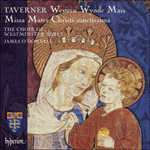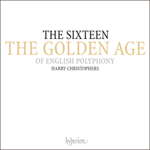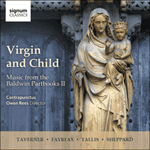The motet
Mater Christi sanctissima was written while Taverner was working at Cardinal College. There was much call for Marian music in Wolsey’s foundation, especially when the text’s very opening emphasized Mary’s role as the mother of Christ. And Taverner’s Continental musical influences lent authentic Roman Catholic exoticism to Wolsey’s new establishment. From the outset, the alternation of the two upper voices and the three lower voices references a Continental soundworld, and carefully sets out its modern vocal space within Wolsey’s new architectural space. The effect is simple and direct, yet sophisticated. This Antiphon to the Virgin Mary has an appropriately feminine lilt, and its harmonies are carefully directed. While its five-voice texture is entirely English (with its high-lying arched treble lines and resonant bass), the antiphonal dialogue punctuated by passages of powerful homophony boasts Franco-Flemish influence. Yet the persistent harmonic cross-relations are integral to the piece’s English modality and more frequent than they would be in Continental church music of the time. The motet
Mater Christi sanctissima survives in the ‘Peterhouse’ partbooks—a sacred anthology that reflects the repertory of the 1530s at Magdalen College. So this motet travelled east down Oxford’s High Street soon after its composition. Sadly, this set of partbooks is missing its tenor book (the second part up from the bass), although
Mater Christi sanctissima is also contained in the ‘Sadler’ partbooks, which date from half a century later. So the piece survives intact, albeit not entirely contemporaneously.
from notes by Jeremy Summerly © 2016
Taverner écrivit le motet
Mater Christi sanctissima alors qu’il travaillait à Cardinal College. La musique mariale faisait l’objet de nombreuses commandes dans la fondation de Wolsey, surtout lorsque le début du texte soulignait le rôle de Marie comme mère du Christ. Et les influences musicales continentales de Taverner donnaient un exotisme catholique romain authentique au nouvel établissement de Wolsey. Dès le début, l’alternance des deux voix supérieures et des trois voix inférieures fait référence à un univers sonore européen et présente soigneusement son espace vocal moderne au sein du nouvel espace architectural de Wolsey. L’effet produit est simple et direct, mais néanmoins sophistiqué. Cette antienne à la Vierge Marie a des inflexions féminines comme il se doit, et ses harmonies sont soigneusement indiquées. Si sa texture à cinq voix est totalement anglaise (avec ses lignes de soprano arquées et sa basse résonante), le dialogue antiphonal ponctué par des passages d’homophonie puissante relève de l’influence franco-flamande. Mais les fausses relations harmoniques continuelles sont intrinsèques à la modalité anglaise de la pièce et plus fréquentes qu’elles ne le seraient dans la musique d’église continentale de l’époque. Le motet
Mater Christi sanctissima subsiste dans les recueils en parties séparées de «Peterhouse»—anthologie sacrée qui reflète le répertoire des années 1530 de Magdalen College. Ce motet s’est donc déplacé vers l’Est jusqu’à High Street à Oxford peu après sa composition. Malheureusement, dans ce recueil de parties séparées, il manque la partie de ténor (la deuxième partie au-dessus de la basse), mais
Mater Christi sanctissima figure aussi dans les recueils en parties séparées de «Sadler», postérieurs d’un demi-siècle. L’œuvre a donc survécu intacte mais pas complètement à la même époque.
extrait des notes rédigées par Jeremy Summerly © 2016
Français: Marie-Stella Pâris
Die Motette
Mater Christi sanctissima entstand, als Taverner am Cardinal College tätig war. Marianische Musik war in Wolseys College sehr gefragt, besonders wenn im Text gleich zu Beginn die Rolle Marias als Mutter Christi hervorgehoben wurde. Die musikalischen Einflüsse des europäischen Kontinents in Taverners Musik verliehen Wolseys neuer Einrichtung eine authentisch römisch-katholische Exotik. Von Anfang an bezieht sich das Alternieren der zwei Ober- und drei Unterstimmen auf die kontinentale Klangwelt und schreitet sorgfältig seinen modernen vokalen Raum innerhalb von Wolseys neuem architektonischen Raum ab. Der Effekt ist schlicht und direkt, doch gleichzeitig differenziert. Diese Antiphon an die Jungfrau Maria besitzt eine entsprechend weibliche Beschwingtheit und die Harmonien werden sorgfältig geführt. Während die fünfstimmige Anlage englischen Ursprungs ist (mit hochliegenden, sich wölbenden Oberstimmen und einem klangvollen Bass), weisen der antiphonische Dialog sowie die Passagen kraftvoller Homophonie franko-flämische Einflüsse auf. Doch sind die anhaltenden harmonischen Querstände ein integraler Bestandteil der englischen Modalität des Stücks und kommen häufiger vor, als es in kontinentaler Kirchenmusik jener Zeit passieren würde. Die Motette
Mater Christi sanctissima ist in den sogenannten „Peterhouse“-Stimmbüchern überliefert—eine Anthologie geistlicher Werke, die das Repertoire am Magdalen College der 1530er Jahre reflektiert. Dem ist also zu entnehmen, dass die Motette schon bald nach ihrer Entstehung sich die High Street in Oxford gen Osten hinunter begab. Leider ist in diesem Satz Stimmbücher das Tenorbuch nicht enthalten (die zweittiefste Stimme), doch findet sich
Mater Christi sanctissima auch in den „Sadler“-Stimmbüchern, die ein halbes Jahrhundert älter sind. Damit ist das Werk also intakt überliefert, selbst wenn die Quellen nicht ganz zeitgenössisch sind.
aus dem Begleittext von Jeremy Summerly © 2016
Deutsch: Viola Scheffel


 Taverner: Missa Mater Christi sanctissima & Western Wynde Mass
Taverner: Missa Mater Christi sanctissima & Western Wynde Mass The Sixteen & The Golden Age of English Polyphony
The Sixteen & The Golden Age of English Polyphony Virgin and Child
Virgin and Child
